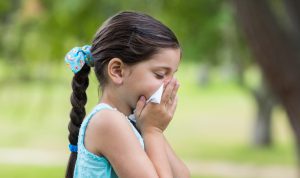Any white patch found on your skin can be an alarming sign that you need to seek serious medical attention before it gets worse and begins spreading. You may begin to wonder as to why is this happening and all you need to do is to stay calm and visit a dermatologist. White patches are also known as depigmentation of the skin and if you are a person who relies on taking self-medication for the purpose, then you might be complicating your skin condition.
You need to note that advice and proper treatment from a specialist are all that matters for a start. So, make it a point to visit a doctor as soon as you come across any white patch or spot on your skin.

White patches are also known as vitiligo which is a skin disease that causes skin discolouration to an extent to which your skin loses its natural colour. In extreme cases, this skin condition can also affect your hair and the inside part of your mouth. So what causes vitiligo? Well, your skin and hair contain melanin and when melanin is not produced, then you may apparently end up suffering from vitiligo.
This may appear to be more deadly on people who are darker. Moreover, this disease is not contagious, but it can lower your self-confidence in public and also causes tremendous stress. The worst part about people suffering from this skin discolouration is that it makes one feel depressed and this thinking itself causes other mental disorders. The treatment for vitiligo includes restoring colour to the affected skin, but this can in no way prevent continued skin colour loss.
Did You Know?
People suffering from this condition may feel bad about how they carry themselves in public, as they might feel a lot more depressed about their looks. So, now that you know what white patches are, let us understand some important facts that surround this skin condition.
Note: If you spot any sort of white patch on your skin, it is strictly advised that you consult a doctor at the earliest. This will at least prevent the disease from growing and promote repigmentation of discoloured skin.
Researchers say that lack of melanin, a skin pigment, is what causes vitiligo. Melanin, which gives your skin its colour, is produced by skin cells called melanocytes. Lack of functioning melanocytes does not allow your skin from producing enough melanin when you have vitiligo. Your skin or hair may start to develop white patches as a result.
Dr. Siddharth Gupta, B.A.M.S, M.D
Now that we know that white patches can affect anyone, let us understand how this is caused and the root cause of this deadly skin condition. White patches are not treated as a serious skin condition but instead as a serious mental condition because it has high chances of affecting a person mentally and his/her surroundings. Here are some of the various skin conditions that cause white patches.
Vitiligo symptoms include skin or mucous membrane patches that have lost their colour. These could have a whiter or paler appearance than your actual skin tone. Your body begins to develop silver, grey, or white patches of hair. Mild cases present with the occurence of these patches in only a limited section of your body while in moderate to severe cases, the entire skin may be greatly affected. Before depigmentation begins, patients may experience itching.
Dr. Rajeev Singh, BAMS
White patches can bring down your self-confidence and as a result, you will have to take medical treatment if you spot any white patch on your skin. This patchy skin loss can be seen in the areas that are exposed to sunlight. These areas can be on hands, feet, arms, lips and face. So, how do you know if you are suffering from vitiligo?. Here are some of the symptoms of skin discolouration that you need to keep in mind.
However, there are many ways in which skin discolouration can affect the body. In terms of its appearance, skin discolouration can appear in many parts of your body such as:
The worst part of vitiligo is when this type of skin discolouration begins appearing on your face. Vitiligo on your face can be caused due to the below-listed diseases.
This is a commonly found chronic skin condition wherein white blood cells cause inflammation on your skin. Your skin cells tend to multiply more rapidly and this shows on the surface of your skin. Psoriasis associates with severe itching and dry skin. Some of the most striking factors responsible for psoriasis is insect bites, smoking, vitamin D deficiency and stress. Sometimes even the consumption of alcohol can trigger psoriasis. This disease can leave white patches on your face.
It is a chronic skin condition that causes inflammation on your skin and later results in the formation of patches on your body. This disease can affect children most often and as a result, this can be treatable. Even though it can be cured, its symptoms begin to show throughout their lives. This skin condition is often associated with severe itching and the formation of rashes around the upper layer of your skin. This can appear on your face, back or even arms.
Skin discolouration can also be caused due to a number of nutritional deficiencies such as vitamin D, vitamin E, calcium that can cause white patches on your face or other parts of your body. Well, though this disease is not contagious, it leaves a big scar on the amount of self-confidence you possess. Also, nutritional deficiencies indicate that you need to follow a healthy and balanced diet.
This type of skin disease is associated with severe itching, dandruff and causes red skin on the face, skin, scalp and chest. This disease is usually caused due to high-level stress among adults. It is also caused by bacteria. Its symptoms can be cured using antifungal creams, medicinal shampoos etc. Also, you must be lucky if you do not get this disease on your face as this can lead to white patches.
Once you have been to a dermatologist, he/she will put you on a medication that is based on your skin condition. However, there are certain home remedies that you must keep in mind when taking medication for your skin condition. Here are some home remedies for treating white patches.
Note: All of the home remedies will benefit you, but you also need to consult a dermatologist regarding the degree of the vitiligo condition and based on which you can ask him/her regarding consuming all of the above.
The first sign that you will have to take seriously is when you spot a white spot on any part of your body. Do not avoid the fact that it might just be a rash. Make it a point to visit a dermatologist as soon as possible, if not you may be inviting trouble. Here are some signs pertaining to vitiligo in which you will have to consult a doctor.
Also, you need to keep in mind that vitiligo has no sort of cure but the treatment is aimed at stopping the spreading of these white patches.
Well, if you have spotted a white patch on your body, then firstly you will have to consult a dermatologist and understand your skin condition. But there are some ways in which you can stop these white patches from spreading to other parts of your body. All you need to do is to follow these below-listed points and you can stay safe from white patches.
Note: The above-listed tips can be followed, provided you are going through a skin treatment for white patches as prescribed by a dermatologist.
Also Read: Goat Milk Soap Benefits: Exploring Its Skin-Boosting Potentials
White patches are not considered as a serious or contagious skin condition, but this can leave a huge mark on your self-confidence and affect the way you act, feel and act in society. Here are some frequently asked questions will shed some more light into the topic of white patches.
White patches, also medically termed as vitiligo cannot be cured but it can be treated and stopped from spreading. This skin condition is a lifelong condition that can affect an individual’s way of thinking in society.
The type of food you consume too has effects on your skin. There are certain kinds of foods that can cause allergies to many. However, there are certain kinds of foods that can worsen white patches and make them spread more. Here are some of those foods that you need to avoid if you are suffering from white patches.
1. Coffee
2. Citrus fruits
3. Yoghurt
4. Seafood
5. Gooseberries; and
6. Alcohol
It is a common myth and nothing more than that. Some people believe that the condition is caused by drinking milk or eating sour food such as lemons and oranges. The fact remains that Vitiligo is an auto-immune disease that has no direct relation to food and it is not caused by eating any specific food. The treatment is never aimed at avoiding any food, it is based on a proven scientific basis.
Eczema, Seborrheic dermatitis and Psoriasis are some of the common causes of dry white patches on the skin.
White patches can be devastating for the person dealing with them. Though science has considered this a normal occurrence, the victim will have to fight the ugly reality of the way he/she looks every day. This skin condition can cause depression and other psychological problems that can hamper a person’s growth and thinking in society. All you need to do is when you have spotted a white patch, you need to consult a dermatologist as soon as possible and you can prevent it from spreading and causing total skin discolouration. Keep in mind, ”Prevention is better than cure.”
Disclaimer: The information provided here is for educational/awareness purposes only and is not intended to be a substitute for medical treatment by a healthcare professional and should not be relied upon to diagnose or treat any medical condition. The reader should consult a registered medical practitioner to determine the appropriateness of the information and before consuming any medication. PharmEasy does not provide any guarantee or warranty (express or implied) regarding the accuracy, adequacy, completeness, legality, reliability or usefulness of the information; and disclaims any liability arising thereof.
Links and product recommendations in the information provided here are advertisements of third-party products available on the website. PharmEasy does not make any representation on the accuracy or suitability of such products/services. Advertisements do not influence the editorial decisions or content. The information in this blog is subject to change without notice. The authors and administrators reserve the right to modify, add, or remove content without notification. It is your responsibility to review this disclaimer regularly for any changes.
Our skin is one of the most sensitive parts of our body and most exposed as well. It is easy for the skin to come in contact with various allergy-causing agents, which triggers reactions.
While there may be multiple symptoms for skin allergy – irritated skin is the most common among those. To delve into what is skin allergy or what causes it, it will help if we look at the different types of skin allergies to understand it better. We are often unable to differentiate between types of allergies but knowing them helps us discuss with our doctors better.

Atopic dermatitis, commonly known as eczema, affects children more than adults. A common skin allergy symptom of eczema is dry, red, irritated and itchy skin. Urine infection, your skin may have small, fluid-filled bumps that ooze a clear or yellowish liquid.
Also Read: White Patches On Skin: Causes, Symptoms And Home Remedies
Hives, also known as urticaria, are red bumps or welts that appear on the body. Differentiated into two types, acute urticaria and chronic urticaria, the former one only lasts for no more than six weeks, whereas the latter stays a little longer than six weeks. Although chronic urticaria’s cause is yet unknown, acute urticaria is predominantly caused by exposure to an allergen in food, medication or by an infection.
The best way to prevent allergies is to avoid allergens. You can also take antihistamines or other medications daily to help control your symptoms and reduce your allergic reaction. If you have animal allergies, avoid petting, hugging or kissing animals. Don’t allow them in your bedroom or on your furniture. Regularly vacuuming rugs, carpets and other surfaces helps remove dust, animal dander, pollen and other allergens. High-efficiency particulate (HEPA) air filters can also help. These air purifiers remove airborne allergens from your environment.
Dr. M.G. Kartheeka, MBBS, MD
Contact dermatitis is a reaction that appears when the skin comes in contact with a foreign material that acts as an irritant or an allergen. Symptoms present themselves as rashes, blisters, itching or burning. Detergents, soaps and excessive exposure to water can cause contact dermatitis. Metals can also be one of the skin allergy causes, stainless steel and other alloys used in jewellery, adhesives, nail polish, topical medications, plants and latex gloves can act as allergens. It is usually presented by red and itchy skin.
At times, an allergen only causes a skin reaction when it is exposed to sunlight called photoallergic contact dermatitis. It can occur due to cosmetic products such as shaving lotion, sunscreen and perfumes.
Also Read: Baking Soda Bath: Research-Based Benefits and How to Do It Properly
As allergies cannot be cured, prevention is the best way for skin allergy treatment. Determining or identifying the cause of your rash is important, so you can avoid it. Wearing Gloves can protect against skin allergy on the face, but if you are already infected, try to ease the symptoms and prevent further infection. Fight off the urge to scratch it as it will only worsen the problem and spread infection. Here’s a list of some skin allergy medication and home remedies that can help relieve the itching and stop the swelling:
Most skin allergies aren’t life-threatening, but a condition called anaphylaxis (severe allergic reaction) can make it difficult to breathe resulting in fatal consequences. While this is usually rare in skin allergies, it’s best to talk to your doctor for a better allergy diagnosis and work out a management plan.
Also Read: Coping Strategies For Stress-Related Eczema On Hands: An Overview
For more information on how you can identify and manage your skin allergies, visit – https://bit.ly/3pMnxFf
Disclaimer: The information provided here is for educational/awareness purposes only and is not intended to be a substitute for medical treatment by a healthcare professional and should not be relied upon to diagnose or treat any medical condition. The reader should consult a registered medical practitioner to determine the appropriateness of the information and before consuming any medication. PharmEasy does not provide any guarantee or warranty (express or implied) regarding the accuracy, adequacy, completeness, legality, reliability or usefulness of the information; and disclaims any liability arising thereof.
Links and product recommendations in the information provided here are advertisements of third-party products available on the website. PharmEasy does not make any representation on the accuracy or suitability of such products/services. Advertisements do not influence the editorial decisions or content. The information in this blog is subject to change without notice. The authors and administrators reserve the right to modify, add, or remove content without notification. It is your responsibility to review this disclaimer regularly for any changes.
Very common in children, an allergy march is when a kid starts to get allergies in a specific order. It’s a condition that starts from eczema, then food allergies and hay fever, eventually leading to asthma. A lot of times people misunderstand mild symptoms which may lead to severe ones, but the development of these diseases is strongly influenced by both genetic and environmental factors. So, let’s look at how this allergic march or atopic march develops in children.
The first stage is allergic sensitization, where a child shows IgE reaction to the food proteins during the first weeks or months. Most commonly developed from egg or cow’s milk, these strong IgE antibodies that respond to food proteins can be considered as triggers for atopic reactivity. Reaction to environmental allergens comes at a later stage as the outdoor allergens require exposure as well.
Dry, red, irritated and itchy skin is the most common symptom during atopic dermatitis. The skin develops small, fluid-filled bumps that ooze a clear or yellowish liquid. Gender difference also plays a role here as the reactions in boys are seen quite early in life, whereas the reactions in girls persist later in adulthood. The elevated rate of total IgE levels and a high degree of sensitization to food protein, has led to the misunderstanding that eczema triggers food allergy. But in most cases, the sensitization is only a complication of atopic march rather than a trigger to another condition.
Food allergy symptoms are far and many but most certain foods such as peanuts, tree nuts, fruits, vegetables allow a risk and potentially life-threatening anaphylactic reactions with significant IgE-responses. So far, the only treatment of food allergy in children is an elimination diet, which is necessary to be carried out for a few years. But high IgE levels from egg or cow’s milk have a less favorable outcome and longer persistence of the disease.
Seasonal allergic rhinitis generally doesn’t show up during the first two years of life. However, it’s possible for children to develop specific IgE-antibodies years before they manifest into something severe. An early reaction in children to grass or pollen allergens can indicate a high risk of rhinitis manifestation in the latter years of life. In some cases, children suffering from allergic rhinitis are known to be at high risk for future asthma manifestation.
Also Read: What Happens If You Eat Mold: Decoding the Potential Health Risks
Signs of asthma can be observed during an early stage of a child’s life. A majority of cases show symptoms of asthma such as asthmatic wheezing but very rarely does it persist throughout school-age and adolescence. The wheezing is not because of allergen-specific sensitization but because of virus infections such as RSV or rhinovirus, and the pattern may change later during school-age. Persistent wheezing shows a connection to indoor allergens like house dust mites and mold etc.

Prevention of allergic diseases and symptoms is the best possible way to fight off the allergic march. Early prevention is recommended which heavily relies on the prevention of triggers in healthy infants. Allergy prevention can be done with certain measures such as avoidance of early allergen contact from foods and inhalants and avoidance of pollution mainly indoor pollutants such as cigarette/tobacco smoke. It’s not necessary that if your child has eczema, they are certain to get the allergy march. It just means there’s a higher chance of it happening if the signs do show up seeking medical attention as soon as possible for the necessary allergy diagnosis.
For more information on how you can identify and manage allergies, visit http://bit.ly/allergy_free
Allergens are everywhere and you need to be mindful before coming in contact with them! Be it trees, grass, weed, pets, dust; an individual is prone to get an allergy anytime and anywhere. You can surely determine & beat them with allergy testing, but we’ve put down a few allergy tips on how you can beat them:
A gorgeous day can ruin your mood in a split-second if the pollen count is high. Especially during some seasons, the pollen count can be at its maximum, so ensure you stay indoors to keep the allergens away and take essential allergy care.
A nasal rinse cleans mucus from your nose and can give you relief from various signs & symptoms of allergies. It also can whisk away bacteria and thin mucus and cut down on postnasal drip. With some easy steps, you can get rid of the bacteria-
Do check with your doctor how to do this before trying it at home for the first time.

Each time you step out, you encounter millions of pieces that can trigger allergies.
A healthy diet always helps in allergy management when it comes to food allergies –
It’s better to know what the problem is before taking some of the steps. Make an appointment with your doctor who can help you identify your allergy triggers. It will make it easier to manage or avoid them.
For more information on how you can identify and manage allergies, visit http://bit.ly/allergy_free
An allergy is a reaction/response by the immune system when it gets exposed to certain foreign substances known as allergens. Allergens can be found anywhere! In some individuals, the body responds and tries to fight them.
The indoor and outdoor allergies can be further segregated into different allergy types that individuals suffer from. Typically, the eyes, nose, lungs, skin and gastrointestinal tract of the body are prone to allergic symptoms. Although the various allergic diseases may appear different, they all result from an exaggerated immune response to foreign substances in sensitive individuals.
According to AAFA There are many types of allergies like dust allergy, food allergy, drug allergy, insect allergy etc. Some allergies are seasonal and others are year-round. Some allergies may be life-long. It is important to work with your health care provider to create a plan to manage your allergy. Avoiding your allergens is the best way to prevent an allergic reaction.
Dr. M.G. Kartheeka, MBBS, MD
What is it: Allergic reaction triggered from a protein found in a pet’s fur, skin flakes, saliva or urine.
Management: There’s no need to get rid of your furry friends. With proper diagnosis by a doctor, pet allergy can be managed easily.
What is it: All paints give out fumes and chemicals which can act as allergens for some individuals in case of inhalation of fumes or direct contact with skin.
Management: Wearing a mask, gloves can help prevent it. Rinsing it off from the skin can help soothe it as well as keeping the area well ventilated is advisable.
What is it: It’s not the dust, but the tiny organisms living in it called dust mites that can trigger an allergic reaction. Apart from dust mites themselves, bed mites, pollen, cockroaches can also trigger a dust allergy!

Management: Vacuuming frequently to keep the surroundings clean can help manage dust allergy in a better way.
What is it: A person gets mold allergy when they inhale mold spores causing various symptoms such as itchy eyes, coughing, etc. Favourable to grow in damp areas, it’s pretty common for mold to exist in one’s bathroom or kitchen.
Management: It is challenging but not impossible. Personal hygiene and cleanliness can help manage mold allergies.
Sinus rinsing can remove dust, pollen and other debris, as well as help to loosen thick mucus. It can also help relieve nasal symptoms of sinus infections, allergies, colds and flu. Plain water can irritate your nose.
Dr. Ashish Bajaj – M.B.B.S, M.D.
What is it: Rapidly increasing air pollution is one of the major causes of allergy. Among the various sources of pollution are emissions from factories and industries, automobiles, crop burning and tobacco.
Management: Unfortunately, it’s tough to control pollution but can be managed/prevented by wearing a mask or staying indoors. Individuals need to contribute to a reduction in air pollution by simple methods like planting trees, walking instead of using vehicles whenever possible, etc.
What is it: Tiny pollen released from the plants, weeds and grass during pollination lead to pollen allergy.
Management: The ratio of pollen increases in certain seasons, so one can avoid going to places where they can inhale them or wear a mask while going outdoors.
What is it: Inhalation of mold spores that dwell in cold and damp places like gardens or backyards can be one of the many reasons for mold allergy.
Management: Stay indoors on days when mold content is high and keep away from uncut fields and raking leaves.
Most of the allergies mentioned above manifest as nasal allergies or allergic rhinitis. There are also skin and food allergies that may show presence in different ways.
Also Read: Montair Lc
What is it: Often a general/harmless food item is mistaken as something foreign/toxic by our immune system, which leads to an allergic reaction.
Causes: The most common triggers of food allergies are peanuts, walnuts, pecans, soy, milk.

Management: Determining the allergen is important and can be managed easily if you avoid consuming it.
What is it: A lot of materials can cause an allergic reaction when they come in contact with your skin.
Causes: Common causes of skin allergy are metals, gold, silver, insects, tobacco and even latex among many others.
Management: Topical ointments and moisturizers can be applied to the affected area to help manage the reaction. It is important to consult your doctor to get the right treatment for your skin allergies.
You must be cautious as allergies may have acute effects many times, it can be lethal for an individual. If you are suspicious about having an allergy, it’s best to reach out to a doctor/physician for an accurate allergy diagnosis.
Also Read: What is the Cause of Nipple Pain? Understanding and Managing Discomfort
Disclaimer: The information provided here is for educational/awareness purposes only and is not intended to be a substitute for medical treatment by a healthcare professional and should not be relied upon to diagnose or treat any medical condition. The reader should consult a registered medical practitioner to determine the appropriateness of the information and before consuming any medication. PharmEasy does not provide any guarantee or warranty (express or implied) regarding the accuracy, adequacy, completeness, legality, reliability or usefulness of the information; and disclaims any liability arising thereof.
Links and product recommendations in the information provided here are advertisements of third-party products available on the website. PharmEasy does not make any representation on the accuracy or suitability of such products/services. Advertisements do not influence the editorial decisions or content. The information in this blog is subject to change without notice. The authors and administrators reserve the right to modify, add, or remove content without notification. It is your responsibility to review this disclaimer regularly for any changes.
Allergies can be stressful and every person around the world is prone to them. But often, people ignore the signs and symptoms of allergy or don’t realize it until they discover a repetition or pattern. So, how does allergy happen? Or what makes you allergic to a particular substance? How crucial is allergy testing?In simple words, when a person’s immune system overreacts to a foreign item (like dust, pollen, dander, etc.) as harmful/hazardous, it responds to it with an allergic reaction. Typically, an allergic reaction only takes a few minutes to develop from being exposed. There are a host of indoor allergies & outdoor allergies that can affect a human body which can be identified through allergy testing. Allergic reactions may vary from mild to severe, so identifying the allergy type is very crucial and should be reported to your doctor.
 Don’t mistake allergy for something trivial. The sooner you identify symptoms, the sooner you can get them treated. If you are suspicious about having an allergy, it’s best to reach out to an expert/physician who can consult you based on the symptoms. Also Read: Montair Lc UsesFor more information on how you can identify and manage allergies, visit http://bit.ly/allergy_free SAIN.ALL.20.01.0181aDisclaimer: The information provided here is for educational/awareness purposes only and is not intended to be a substitute for medical treatment by a healthcare professional and should not be relied upon to diagnose or treat any medical condition. The reader should consult a registered medical practitioner to determine the appropriateness of the information and before consuming any medication. PharmEasy does not provide any guarantee or warranty (express or implied) regarding the accuracy, adequacy, completeness, legality, reliability or usefulness of the information; and disclaims any liability arising thereof.Links and product recommendations in the information provided here are advertisements of third-party products available on the website. PharmEasy does not make any representation on the accuracy or suitability of such products/services. Advertisements do not influence the editorial decisions or content. The information in this blog is subject to change without notice. The authors and administrators reserve the right to modify, add, or remove content without notification. It is your responsibility to review this disclaimer regularly for any changes.
Don’t mistake allergy for something trivial. The sooner you identify symptoms, the sooner you can get them treated. If you are suspicious about having an allergy, it’s best to reach out to an expert/physician who can consult you based on the symptoms. Also Read: Montair Lc UsesFor more information on how you can identify and manage allergies, visit http://bit.ly/allergy_free SAIN.ALL.20.01.0181aDisclaimer: The information provided here is for educational/awareness purposes only and is not intended to be a substitute for medical treatment by a healthcare professional and should not be relied upon to diagnose or treat any medical condition. The reader should consult a registered medical practitioner to determine the appropriateness of the information and before consuming any medication. PharmEasy does not provide any guarantee or warranty (express or implied) regarding the accuracy, adequacy, completeness, legality, reliability or usefulness of the information; and disclaims any liability arising thereof.Links and product recommendations in the information provided here are advertisements of third-party products available on the website. PharmEasy does not make any representation on the accuracy or suitability of such products/services. Advertisements do not influence the editorial decisions or content. The information in this blog is subject to change without notice. The authors and administrators reserve the right to modify, add, or remove content without notification. It is your responsibility to review this disclaimer regularly for any changes.